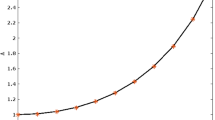Abstract
A new class of time-integrators is presented for strongly nonlinear dynamical systems. These algorithms are far superior to the currently common time integrators in computational efficiency and accuracy. These three algorithms are based on a local variational iteration method applied over a finite interval of time. By using Chebyshev polynomials as trial functions and Dirac–Delta functions as the test functions over the finite time interval, the three algorithms are developed into three different discrete time-integrators through the collocation method. These time integrators are labeled as Chebyshev local iterative collocation methods. Through examples of the forced Duffing oscillator, the Lorenz system, and the multiple coupled Duffing equations (which arise as semi-discrete equations for beams, plates and shells undergoing large deformations), it is shown that the new algorithms are far superior to the 4th order Runge–Kutta and ODE45 of MATLAB, in predicting the chaotic responses of strongly nonlinear dynamical systems.









Similar content being viewed by others
References
Adomian G (1988) A review of the decomposition method in applied mathematics. J Math Anal Appl 135:501–544
Atluri SN (2005) Methods of computer modeling in engineering & the sciences, vol I. Tech Science Press, Forsyth
Bai X, Junkins JL (2011) Modified Chebyshev–Picard iteration methods for solution of boundary value problems. Journal of Astronaut Sci 58(4):615–642
Cheung YK, Chen SH, Lau SL (1991) A modified Lindstedt–Poincare method for certain strongly nonlinear oscillators. Int J Nonlinear Mech 26(3/4):367–378
Dai HH, Schnoor M, Alturi SN (2012) S simple collocation scheme for obtaining the periodic solutions of the Duffing equation, and its equivalence to the high dimensional harmonic balance method: subharmonic oscillations. Comput Model Eng Sci 84(5):459–497
Dong L, Alotaibi A, Mohiuddine SA, Atluri SN (2014) Computational methods in engineering: a variety of primal & mixed methods, with global & local interpolations, for well-posed or ill-posed BCs. Comput Model Eng Sci 99(1):1–85
Elgohary TA, Dong L, Junkins JL, Atluri SN (2014) A simple, fast, and accurate time-integrator for strongly nonlinear dynamical systems. Comput Model Eng Sci 100(3):249–275
Fehlberg E (1969) Low-order classical Runge-Kutta fomulae with stepsize control and their application to some heat transfer problems. Technical report, NASA
Fukushima T (1997) Picard iteration method, Chebyshev polynomial approximation, and global numerical integration of dynamical motions. Astron J 113(5):1909–1914
Har J, Tamma K (2012) Advances in computational dynamics of particles, materials and structures. Wiley, West Sussex
He J (1999) Variational iteration method: a kind of non-linear analytical technique: some examples. Int J Nonlinear Mech 34:699–708
He J (2006) Homotopy perturbation method for solving boundary value problems. Phys Lett A 350(1–2):87–88
Hilber HM, Hughes TJ, Taylor RL (1977) Improved numerical dissipation for time integration algorithms in structural dynamics. Earthq Eng Struct Dyn 5(3):283–292
Inokuti M, Sekine H, Mura T (1978) General use of the Lagrange multiplier in nonlinear mathematical physics. In: Nemat-Nasser S (ed) Variational method in the mechanics of solids. Pergamon Press, Oxford, pp 156–162
Jang M, Chen C, Liy Y (2000) On solving the initial-value problems using the differential transformation method. Appl Math Comput 115:145–160
Liu CS, Yeih W, Kuo CL, Atluri SN (2009) A scalar homotopy method for solving an over/under determined system of non-linear algebraic equations. Comput Model Eng Sci 53(1):47–71
Liu CS, Atluri SN (2011) An iterative algorithm for solving a system of nonlinear algebraic equations, \({ F}({ x})={ 0}\), using the system of ODEs woth an optimum \(\alpha \) in \(\dot{{ x}}=\lambda [\alpha { F}+(1-\alpha ){ B}^{T}{ F}]\); \(B_{ij} ={\partial F_i }/{\partial x_j }\). Comput Model Eng Sci 73(4):395–431
Liu L, Dowell EH, Hall K (2007) A novel harmonic balance analysis for the van der pol oscillator. Int J Nonlinear Mech 42(1):2–12
Newmark NM (1959) A method of computation for structural dynamics. J Eng Mech Div 85(3):67–94
Thomas JP, Hall KC, Dowell EH (2003) A harmonic balance approach for modeling nonlinear aeroelastic behavior of wings in transonic viscous flow. AIAA Paper No. 1924, pp 1–6
Wang X, Atluri SN (2016) A unification of the concepts of the variational iteration, adomian decomposition and picard iteration methods; and a local variational iteration method. Comput Model Eng Sci 111(6):567–585
Acknowledgements
The authors thank Texas Tech University for its support. The first author also gratefully acknowledges the guidance from Professor Atluri, and the support from China Scholarship Council and Northwestern Polytechnical University.
Author information
Authors and Affiliations
Corresponding author
Rights and permissions
About this article
Cite this article
Wang, X., Atluri, S.N. A novel class of highly efficient and accurate time-integrators in nonlinear computational mechanics. Comput Mech 59, 861–876 (2017). https://doi.org/10.1007/s00466-017-1377-4
Received:
Accepted:
Published:
Issue Date:
DOI: https://doi.org/10.1007/s00466-017-1377-4




